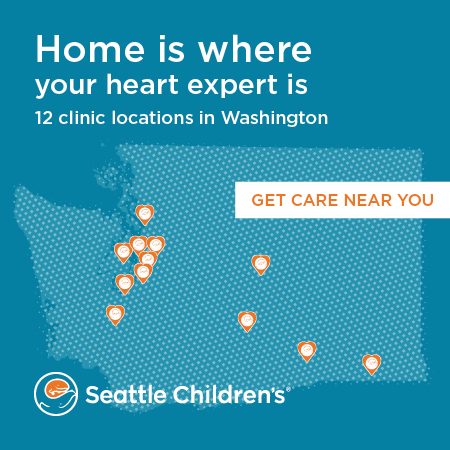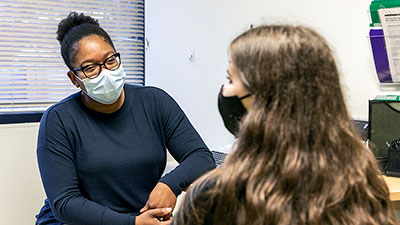Eating Disorders
What is an eating disorder?
Eating disorders are serious physical and mental illnesses. Often, they involve an unhealthy concern (preoccupation) with eating, exercise, body weight or shape. They typically start around the preteen and teen years. People of all sizes and genders and from all cultures and backgrounds can have an eating disorder.
Eating disorders can have major effects on a child’s or teen’s quality of life. They can cause severe, life-threatening health problems. Early diagnosis and treatment can prevent problems and promote a happy, healthy life.
What are the different types of eating disorders?
-
Anorexia nervosa and atypical anorexia nervosa
People with anorexia nervosa (anorexia) often limit or decrease the amount and types of food they eat. This causes them to lose large amounts of weight, which can stop their bodies from working correctly. They may also vomit, take laxatives or exercise too much to control their weight. People with anorexia are often very hard on themselves. They often feel bad about food and their body weight, no matter their shape or size. People with atypical anorexia have the same symptoms, except their weight is in the normal range or higher.
-
Avoidant restrictive food intake disorder (ARFID)
People with ARFID are very choosy about what they eat. Many do not eat certain types of food. Over time, this can cause problems with the way their bodies work and how they grow. ARFID does not involve distress about body shape or size, but some people may feel upset about having a low weight.
-
Binge eating disorder
People with binge eating disorder eat large amounts of food in a short time on a regular basis, usually at least 1 time per week. They feel out of control about what they eat or how much or how quickly they eat. Sometimes they eat when they are not hungry or when they are already so full that eating causes discomfort. They may hide their eating and feel upset, ashamed or guilty about it.
-
Bulimia nervosa
People with bulimia nervosa (bulimia) go back and forth between eating more than their body needs (binging) and purging (getting rid of calories through vomiting or exercise). Over time, this can cause many problems with the way their bodies work. People with bulimia may lose and regain weight. They are often very hard on themselves and feel bad about food and their body weight, no matter their shape or size.
-
Other specified feeding and eating disorders (OSFED)
People with OSFED eat in ways that cause problems for them, but their eating does not meet all of the criteria for any other eating disorder. Some common forms of OSFED are orthorexia, body dysmorphic disorder, doing more exercise than is healthy or feeling driven to exercise too much. Over time, this can cause problems with the way the body works.
-
Pica
People with pica eat things that are not typically thought of as food and do not provide nutrition. They have a strong urge (compulsion) to do this. This is different from young children putting nonfood items, like toys, in their mouth as a normal part of development.
-
Rumination disorder
In people with this condition, swallowed food comes back up into their mouth. They do not bring the food back up on purpose. It happens without them meaning to do it. The food is not yet digested (it tastes normal, not like vomit). They may rechew and reswallow it or spit it out. This behavior is not caused by another condition, like gastroesophageal reflux. The cause isn’t clear. It may have to do with increased pressure in the belly and relaxation of the diaphragm or the flap between the stomach and the tube that carries food to the stomach (esophagus). For some people, mental or emotional distress may play a part.
Adolescent Medicine at Seattle Children's
What are the symptoms of eating disorders?
The symptoms of different eating disorders can vary. If you are concerned about any changes in your child’s eating, food choices or weight, talk with your child’s primary care provider.
A person with an eating disorder may:
- Limit or lower the amount and types of food they eat or be very choosy about what they eat. This may cause them to lose weight.
- Vomit, take laxatives or supplements, increase their activity or exercise too much in order to lose weight.
- Often eat much more food than is typical.
- Go back and forth between eating too much (binging) and then vomiting or exercising too much (purging).
- Hide their eating or their purging.
- Leave during or right after meals to spend time in the bathroom, where they may vomit.
- Not think clearly. When the brain is not getting enough energy, logic and judgment are often impaired. For example, you may say “I’m worried about your weight,” and they may hear “I want you to be fat.”
- Have a distorted body image. For example, a very thin person with an eating disorder may look into a mirror and see a fat person.
- Fear gaining weight or feel bad about food and their body weight, no matter their shape or size. They may complain about their weight, talk about weight-related worries, often check their appearance in the mirror or check their weight on a scale.
- Complain of stomach discomfort after eating a meal.
- Be constipated. The stomach, intestines and colon may have slowed down from lack of food.
- Have problems sleeping. This can happen when the body is not getting enough nutrients.
- Drink more water and caffeinated drinks and use artificial sweeteners to help control their appetite.
- Have an unusually high interest in cooking or healthy eating or try to control the family’s cooking.
Over time, eating disorders can lead to a wide range of other health problems that affect many parts of the body and cause other symptoms.
-
When is emergency care needed?
Take your child to the nearest emergency room or call 911 if they have any of these symptoms along with a suspected or known eating disorder:
- Chest pain
- Shortness of breath
- Feeling like their heartbeat is “off” or irregular
- Dizziness to the point where your child feels like they will faint
- Fainting or loss of consciousness
- Bright red or dark blood in vomit
- Maroon or black blood in the stool
- Very bad stomach (abdominal) pain
- Seeming unusually slow, confused, unresponsive or uncoordinated
If you are not sure whether your child needs to go to the emergency room, take them or call 911. Eating disorders can affect the heart, lungs, kidneys, brain and other organs. Getting your child quick medical care can help avoid lasting damage to their body.
How are eating disorders diagnosed?
A medical provider (doctor, nurse practitioner or physician assistant) or a mental health provider can diagnose an eating disorder.
The provider will ask about your child’s health history, family health history and symptoms. They will also ask about your child’s thoughts, beliefs, feelings and behaviors related to eating and their body.
A medical provider will check your child’s vital signs and do a physical exam. In some cases, they may also ask your child to have tests, like blood or urine tests or an ECG/EKG (electrocardiogram), to rule out other conditions that may affect eating or to check for problems caused by an eating disorder.
How are eating disorders treated?
Treatment for eating disorders typically involves:
- Medical and nursing care to check your child’s health on a regular schedule and treat any physical problems
- Nutritional counseling to help your child form a positive relationship with food and adopt nourishing ways of eating
- Group therapy, family-based therapy, individual therapy or a combination to improve your child’s eating habits, weight, mood, relationships and skills for coping with problems and stresses
- Support from a social worker who can connect your family with helpful resources
Often, care is clinic-based (outpatient). This can include intensive outpatient programs, where children and caregivers participate in therapy, skill-building groups and other forms of care several times a week for a few weeks or longer.
Some treatment facilities offer:
- Partial hospitalization — Your child gets treatment at the facility during the day and goes home at night. (Despite the name, this is not typically at a hospital.)
- Residential program — Your child temporarily lives at the facility to receive treatment.
There may be times when your child needs to stay in the hospital, such as if they have severe malnutrition or another serious health problem due to an eating disorder.
Why choose Seattle Children’s for eating disorders treatment?
Seattle Children’s Eating Disorders Recovery Program provides medical, nutrition and mental health support for children and teens with eating disorders, including anorexia nervosa, avoidant restrictive food intake disorder, binge eating disorder, bulimia nervosa, and other specified feeding or eating disorder.
-
The experts you need are here
- Our eating disorders care team includes medical doctors, nurse practitioners, physician assistants, nurses, registered dietitians, social workers and mental health providers who work together to help young people get better.
- We have specialized training in how to diagnose and provide care for children and adolescents who are affected by eating disorders.
- Families come to our Eating Disorders Recovery Program for medical and nutrition concerns, mental health concerns or both. We will connect you with Seattle Children’s providers and resources from different specialties to match your child’s current needs.
-
Care custom-made for your child
- As we assess your child’s needs and make a care plan for them, we consider their age and stage of development. This allows us to address your child’s health needs now and into the future.
- To make sure your child gets comprehensive care, we also work with their providers outside Seattle Children’s, such as a primary care provider or mental health therapist.
- When your child starts care here, part of our role is to assist in finding the right combination of providers and services for your child’s condition. We provide information about care options and how to access a range of resources.
-
Resources for your child and family
- We often have more appointment requests than openings. If we do not have openings, it is still important to get care when your child needs it. There are many mental health resources in the community that can help.
- Find more resources on eating disorders and treatment.
Contact Us
For more information, contact the Eating Disorders Recovery Program.
- Medical and nutrition concerns: call Adolescent Medicine at 206-987-2028.
- Mental health concerns: call Psychiatry and Behavioral Medicine at 206-987-2164.
If you would like an appointment, ask your child’s primary care provider or mental health therapist for a referral.
Providers, see how to refer a patient.
Related Links
Paying for Care
Learn about paying for care at Seattle Children’s, including insurance coverage, billing and financial assistance.
In crisis?
If you, your child, family or friend needs help right away, call, chat or text 988. The free and confidential 988 Suicide & Crisis Lifeline is available 24 hours a day, 7 days a week in the United States to provide support for people in distress, as well as prevention and crisis resources.
Deaf/Hard of Hearing people can get help through 988 or the Deaf Crisis Line.
Seattle Children’s Psychiatric Urgent Care offers in-person and video visits for same-day mental health support for children and teens ages 4 through 17 who may not need the services of an emergency department.
Hotlines for Youth (PDF) provides other options for immediate help for children and teens. (Also available in Amharic, Arabic, Russian, Simplified Chinese, Somali, Spanish, Ukrainian and Vietnamese.)


